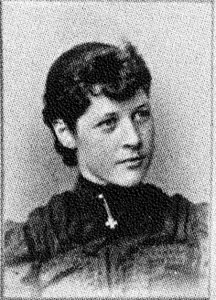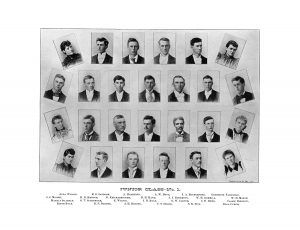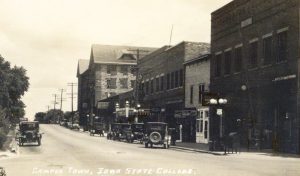
The Wilson sisters of ISU civil engineering history are known for their academic achievements. Lesser-known is the younger sister’s brick-and-mortar contribution to Iowa State’s campus environment.
*Co-authored by Kate Tindall and Kristin Clague
Today, women teaching at Iowa State University (ISU) probably don’t worry about finding a place to live near campus. Students, faculty and alums may be surprised to find that, prior to 1922, both female students and faculty members sometimes struggled to find housing.[1]
One of Iowa State’s great female duos is the Wilson sisters. Elmina Wilson’s claim to fame lies in her status as the first female to graduate from Iowa State College’s (ISC) engineering program.[2] Both Elmina and her younger sister, Alda, are alumni of the current ISU Department of Civil, Construction and Environmental Engineering.
ISU history buffs may know that Alda was also an ISC civil engineering graduate and head of the first women’s drafting department of the Highway Commission (now the Iowa Department of Transportation). But even Iowa State history scholars are not always familiar with the story of Ames’ Cranford Apartments, or the ties Alda Wilson had to the building.
Cranford Apartments sit at the southwest corner of Lincoln Way and Stanton Avenue in Ames’ Campustown. Jeff’s Pizza is housed in the lower level of the building. The upper levels, which previous property owner Marilyn Alger and her brother, Monte Gibbs, renovated is where the mystery lies and where Alda’s role in the construction of the building comes into play.
Cranford Apartments has been in Alger’s family for two generations. Alger and her brother inherited the building from her parents, Earl and Mickey Gibbs, in 1995. Before that, Cranford changed hands several times. That story starts with important historic women leaders in Ames, including Alda Wilson.

“I started the process of researching the Cranford in 2015, when we received one of the first City of Ames Campustown Facade Grants … my husband would call it an obsession,” Alger says with a smile. “There were some days where I would probably spend six to eight hours both in internet searches and at the library researching.”
Alda graduated with her bachelor’s degree in civil engineering in 1894, the same year that her sister Elmina graduated with her master’s degree. Alda pursued her graduate studies at the Massachusetts Institute of Technology from 1897 to 1898. Both sisters would go on to tour Europe, take critical roles in the Suffrage Movement and hold successful careers. This story, however, circles around Alda’s direct impact on the Ames community.
In a November 1922 Iowa State publication, The Alumnus, a short article ran titled “New Apartment for Faculty Women.” The article described how a local group “made up largely of faculty women” had funded the effort to create accessible living quarters for single women faculty members. In the article, Alda Wilson is named as the superintendent of construction. These apartments were the Cranford Apartments
Twenty-first century readers may wonder at the importance of such a seemingly unimportant building. Prior to Cranford, single women serving as faculty members had difficulty renting living quarters in Ames. Limited options included boarding with established families, but this was not enough to meet an ever-growing need.

“The women who were involved in the founding of the Faculty Women’s Housing Company – Cranford Apartments – were strong, important women at the college,” Alger says. “These were women who were movers and shakers.”
Alger believes Alda may have been in conversations with the founding members of the housing company when the name “Cranford” was chosen. During their time traveling abroad, the Wilson sisters visited England and perhaps stopped in the London suburb of Cranford. In addition, the Ames P.E.O Society (a majority of whose members were women leaders on campus) hosted a staging of the play “Cranford” during a dramatic evening in 1909. Written by Victorian-era author Elizabeth Gaskell, the play “Cranford” described the successes and trials of the fictional town of Cranford, where a strong community of women thrived.
In addition, the Sanitary Building, which was a campus building located near the current location of Iowa State’s Memorial Union, had a floor named Cranford. This was the floor where the Faculty Women’s Club met. The building was torn down in 1927 to build today’s Memorial Union. All of these are potential reasons for the naming of the building.
“They knew the book Cranford, a popular book in the late 1800s and early 1900s by Elizabeth Gaskell,” Alger explains. “They liked it well enough to put on the play for the Ames women’s service club, P.E.O. To me, those are all connections.”
Made up of influential Ames natives like Estelle D. Buchanan, Maria Mabel Roberts and Julia Wentch Stanton, the Faculty Women’s Housing Company provided a place for single female faculty members to live with other professional women. Well-known renters included Ada Hayden, the first woman to earn a doctoral degree at Iowa State. The building was sold to Robert E. and Estelle Buchanan in 1953.
Alger, along with her brother Monte, have worked to restore the Cranford Apartments with a nod to historical integrity. They have currently earned two City of Ames Façade Grants to restore the Lincoln Way and Stanton Avenue sides of the building. They have also taken on an entire courtyard redesign and refinished hardwood floors, which were original to the building.
As a crowning touch, Alger has named individual apartments after significant founding members of the Faculty Women’s Housing Company and leading women of Ames who lived in the rooms. A resident may end up living in no. 23, the Ada Hayden room or in the Alda Wilson room. Recently, Alger and her brother sold the property to a local private investor. But Alger’s passion for the history of Cranford and of the women involved remains.
“I encourage women to be inspired by these stories and to think, ‘If they did that, what can we do?’” Alger says.
That echos the passion that Alda and Elmina themselves embodied.[3]
“A girl must take into account that, as yet, she is a pioneer in the profession, which implies more or less opposition, not on account of her intellectual or physical limitations but of artificial conventions, the remnants of a past condition of society,” they wrote in an addition of The Arrow of Pi Beta Phi, a sorority to which the sisters belonged. “Working with men who will take each other at face value, she will need to produce proofs of capability at every step.”
Footnotes
[1] Schilletter, J. C., “The First 100 Years of Residential Housing at Iowa State University, 1868–1968” (1970). Department of Residence Books. 1. http://lib.dr.iastate.edu/housing_books/1. pg. 68-78.
[2] Alda and Elmina Wilson Papers, 1902-2010, undated. Special Collections Department, Iowa State University. http://findingaids.lib.iastate.edu/spcl/arch/rgrp/21-7-24.html.
[3] Alda H. and Elmina Wilson. The Arrow of Pi Beta Phi. “Architecture as a profession for women.” Jan. 1919. Vol 39(2). pg. 214. Special Collections at Iowa State University.
Follow ISU CCEE on Facebook, Twitter and LinkedIn (search “Iowa State University Civil, Construction and Environmental Engineering” and “ISUConE”). NEW: now follow ISU CCEE on Snapchat and Instagram for the latest updates. Find our website at www.ccee.iastate.edu. More information can be found at the following:
Women’s History Month: Civil Engineers Alda and Elmina Wilson
